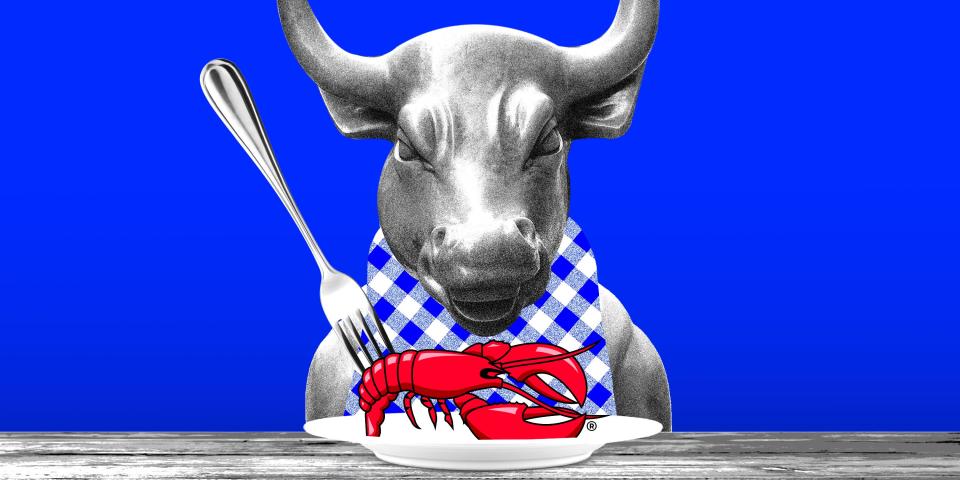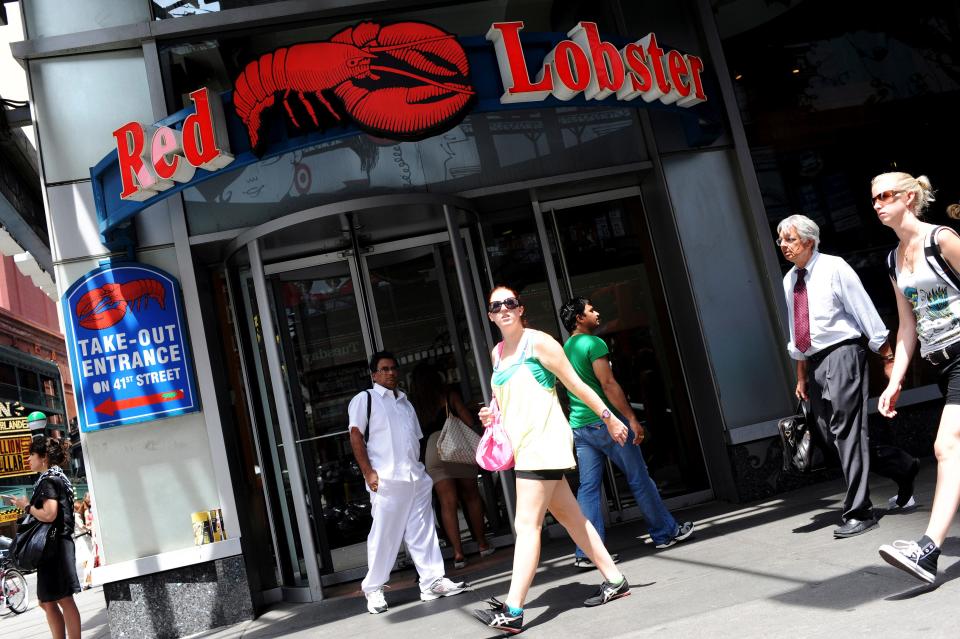The demise of Red Lobster is a perfect case study in how to kill a business

With the chain on the verge of bankruptcy, it has become abundantly clear that Red Lobster letting customers eat all the shrimp their hearts desire was not a great business idea. It's also not the reason the restaurant is in a deep financial mess.
In mid-April, Bloomberg reported the debt-laden seafood chain and home of beloved cheddar biscuits was considering filing for Chapter 11 bankruptcy protection. Red Lobster is being bogged down by increased labor costs and expensive leases on its restaurants. Some observers were quick to blame the financial woes on its decision last year to make its "Endless Shrimp" promotion, which used to be an occasional, limited-time offering, permanent. The move was not a smart one. While Red Lobster increased traffic somewhat, people coming in to chow down on all-you-can-eat shrimp was a money bleeder. The company blamed Endless Shrimp for its $11 million losses in the third quarter of 2023, and in the fourth quarter, the picture got even worse, with the restaurant chain seeing $12.5 million in operating losses.
But the story about what's gone wrong with Red Lobster is much more complicated than a bunch of stoners pigging out on shrimp (and, later, lobster) en masse. The brand has been plagued by various problems — waning customer interest, constant leadership turnover, and, as has become a common tale, private equity's meddling in the business.
"If anything, the Endless Shrimp deals are probably as much a symbol of just either desperation or poor management or both," Jonathan Maze, the editor in chief of Restaurant Business Magazine, said.
Red Lobster first opened in Lakeland, Florida, in 1968 and was acquired by the food conglomerate General Mills in 1970. General Mills then spun the chain off in 1995 along with the rest of its restaurant division, which also included Olive Garden, as Darden Restaurants. In 2014, amid flagging sales and pressure from investors, Darden sold Red Lobster for $2.1 billion to Golden Gate Capital, a San Francisco private-equity firm.
To raise enough cash to make the deal happen, Golden Gate sold off Red Lobster's real estate to another entity — in this case, a company called American Realty Capital Properties — and then immediately leased the restaurants back. The next year, Red Lobster bought back some sites, but many of its restaurants were suddenly strapped with added rent expenses. Even if Darden had kept Red Lobster, it's not clear it would have taken a different route: A press release from the time says it had contacted buyers to explore such a transaction. But in Maze's view, the sale of the real estate was sort of an original sin for Red Lobster's current troubles. He compared it to throwing out a spare parachute — chances are, you'll be OK, but if the first parachute fails, you're in deep trouble.
"The thing that private equity does is just unload assets and monetize assets. And so they effectively paid for the purchase of Red Lobster by selling the real estate," he said. "It'll probably be fine, generally, but there's going to come a time in which your sales fall, your profitability is challenged, and your debt looks too bad, and then suddenly those leases are going to look awfully ugly."
That time, according to recent reporting, is now. With struggling sales and operational losses, the leases are an added headache that is helping push the company to the brink, though bankruptcy may help Red Lobster get some wiggle room on them.
Eileen Appelbaum, a codirector of the Center for Economic and Policy Research, a progressive think tank, and a longtime private-equity critic, said in 2014 that private equity wouldn't be the solution to Red Lobster's ills. She isn't surprised about how this is all turning out.
"Once they sell the real estate, then the private-equity company is golden, and they've made their money back and probably more than what they paid," she said, noting that this was a common theme in other restaurants and retailers and adding: "The retail apocalypse is all about having your real estate sold out from under you so that you have to pay the rent in good times and in bad."
After the real estate move, Golden Gate sold 25% of the company in 2016 to Thai Union, a Thailand seafood company, for $575 million and unloaded the rest of the company to an investor group called the Seafood Alliance, of which Thai Union was a part, in 2020. Golden Gate likely came out ahead, but the same can't be said for Thai Union, which also controls the Chicken of the Sea brand. It is now looking to get out of its stake in Red Lobster and took a one-time charge of $530 million on its investment in the fourth quarter of last year. In 2021, Red Lobster refinanced its debt, with one of its new lenders being Fortress Investment Group, an investment-management group and private-equity firm. According to Bloomberg, it's one of the "key lenders" involved in debt negotiations now.

Beyond the pandemic-related troubles that hit restaurants across the country, analysts and experts say that Red Lobster's particular problems are attributable to a mix of poor brand positioning and unstable leadership. The seafood-restaurant business is a tough one in the US, and people who are hankering for lobster or fish are increasingly going to steak houses that offer those options, said Darren Tristano, the CEO and founder of Foodservice Results, a food-industry consultancy.
"What's truly happened with Red Lobster is that the consumer base has changed and Red Lobster hasn't," he said. "Red Lobster isn't losing to a competitor in their space — they're losing to competitors outside their space."
John Gordon, a restaurant analyst in San Diego, said Red Lobster had been on the decline for 20 years but that it didn't "fall on the knife" until Thai Union got it. "They were totally unprepared to hold a casual-dining restaurant," he said. Kim Lopdrup, Red Lobster's longtime CEO, retired in 2021, and since then, the restaurant hasn't had much in the way of stable leadership. His successor resigned after only a matter of months, and the role remained vacant for more than a year before someone else was appointed. He's left, too, and now Jonathan Tibus, an expert in restructuring, is at the helm.
"One of the problems is that Thai Union just had no credibility in terms of recruiting a new CEO," Gordon said.
Essentially, Red Lobster finds itself in a landscape where there just aren't a lot of bright spots. Add on the weight of the debt and lease obligations the company's private-equity owners saddled the brand with, and a turnaround becomes a gargantuan task.
"It's hard to blame leadership when you have a problem that is unsolvable — I mean, getting the consumer back in the door, increasing traffic. All-you-can-eat shrimp can only do so much," Tristano said.
Red Lobster did not respond to a request for comment for this story. Golden Gate declined to comment. Thai Union pointed to a press release about its intention to exit its investment and said it didn't wish to comment further.
As to what drove Red Lobster to the edge, it's clear that despite not being a very good idea, the blame doesn't fall on Endless Shrimp. Years of changing tastes, tough industry conditions, and poor brand management all contributed to the chain's difficult position. But plenty of other restaurants have faced similar issues and aren't on the verge of bankruptcy. What separates Red Lobster is a decade of private-equity and investor tampering. Pinging from owner to owner makes it hard to settle on a turnaround vision. The company faces challenges that necessitate a long-term view that requires patience — the kind that the short-term-focused Wall Street often struggles to tackle. Whether Red Lobster can turn it around from here remains to be seen: Even if it files for bankruptcy protection, the chain may not disappear. Plenty of companies go bankrupt and keep on keeping on.
"You've got to at least be able to pay your bills, and what's happened over the last five years is the cost of operating a restaurant has taken off," Maze said. "One bad promotion should not doom a restaurant chain like that."
Emily Stewart is a senior correspondent at Business Insider, writing about business and the economy.
Read the original article on Business Insider
